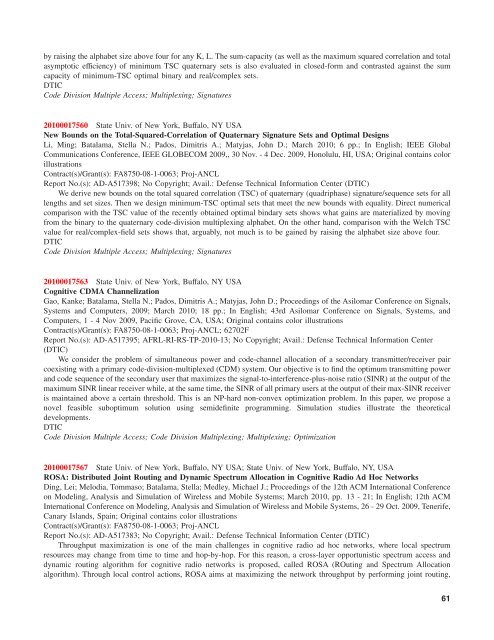NASA Scientific and Technical Aerospace Reports - The University ...
NASA Scientific and Technical Aerospace Reports - The University ...
NASA Scientific and Technical Aerospace Reports - The University ...
Create successful ePaper yourself
Turn your PDF publications into a flip-book with our unique Google optimized e-Paper software.
y raising the alphabet size above four for any K, L. <strong>The</strong> sum-capacity (as well as the maximum squared correlation <strong>and</strong> total<br />
asymptotic efficiency) of minimum TSC quaternary sets is also evaluated in closed-form <strong>and</strong> contrasted against the sum<br />
capacity of minimum-TSC optimal binary <strong>and</strong> real/complex sets.<br />
DTIC<br />
Code Division Multiple Access; Multiplexing; Signatures<br />
20100017560 State Univ. of New York, Buffalo, NY USA<br />
New Bounds on the Total-Squared-Correlation of Quaternary Signature Sets <strong>and</strong> Optimal Designs<br />
Li, Ming; Batalama, Stella N.; Pados, Dimitris A.; Matyjas, John D.; March 2010; 6 pp.; In English; IEEE Global<br />
Communications Conference, IEEE GLOBECOM 2009,, 30 Nov. - 4 Dec. 2009, Honolulu, HI, USA; Original contains color<br />
illustrations<br />
Contract(s)/Grant(s): FA8750-08-1-0063; Proj-ANCL<br />
Report No.(s): AD-A517398; No Copyright; Avail.: Defense <strong>Technical</strong> Information Center (DTIC)<br />
We derive new bounds on the total squared correlation (TSC) of quaternary (quadriphase) signature/sequence sets for all<br />
lengths <strong>and</strong> set sizes. <strong>The</strong>n we design minimum-TSC optimal sets that meet the new bounds with equality. Direct numerical<br />
comparison with the TSC value of the recently obtained optimal bindary sets shows what gains are materialized by moving<br />
from the binary to the quaternary code-division multiplexing alphabet. On the other h<strong>and</strong>, comparison with the Welch TSC<br />
value for real/complex-field sets shows that, arguably, not much is to be gained by raising the alphabet size above four.<br />
DTIC<br />
Code Division Multiple Access; Multiplexing; Signatures<br />
20100017563 State Univ. of New York, Buffalo, NY USA<br />
Cognitive CDMA Channelization<br />
Gao, Kanke; Batalama, Stella N.; Pados, Dimitris A.; Matyjas, John D.; Proceedings of the Asilomar Conference on Signals,<br />
Systems <strong>and</strong> Computers, 2009; March 2010; 18 pp.; In English; 43rd Asilomar Conference on Signals, Systems, <strong>and</strong><br />
Computers, 1-4Nov2009, Pacific Grove, CA, USA; Original contains color illustrations<br />
Contract(s)/Grant(s): FA8750-08-1-0063; Proj-ANCL; 62702F<br />
Report No.(s): AD-A517395; AFRL-RI-RS-TP-2010-13; No Copyright; Avail.: Defense <strong>Technical</strong> Information Center<br />
(DTIC)<br />
We consider the problem of simultaneous power <strong>and</strong> code-channel allocation of a secondary transmitter/receiver pair<br />
coexisting with a primary code-division-multiplexed (CDM) system. Our objective is to find the optimum transmitting power<br />
<strong>and</strong> code sequence of the secondary user that maximizes the signal-to-interference-plus-noise ratio (SINR) at the output of the<br />
maximum SINR linear receiver while, at the same time, the SINR of all primary users at the output of their max-SINR receiver<br />
is maintained above a certain threshold. This is an NP-hard non-convex optimization problem. In this paper, we propose a<br />
novel feasible suboptimum solution using semidefinite programming. Simulation studies illustrate the theoretical<br />
developments.<br />
DTIC<br />
Code Division Multiple Access; Code Division Multiplexing; Multiplexing; Optimization<br />
20100017567 State Univ. of New York, Buffalo, NY USA; State Univ. of New York, Buffalo, NY, USA<br />
ROSA: Distributed Joint Routing <strong>and</strong> Dynamic Spectrum Allocation in Cognitive Radio Ad Hoc Networks<br />
Ding, Lei; Melodia, Tommaso; Batalama, Stella; Medley, Michael J.; Proceedings of the 12th ACM International Conference<br />
on Modeling, Analysis <strong>and</strong> Simulation of Wireless <strong>and</strong> Mobile Systems; March 2010, pp. 13 - 21; In English; 12th ACM<br />
International Conference on Modeling, Analysis <strong>and</strong> Simulation of Wireless <strong>and</strong> Mobile Systems, 26 - 29 Oct. 2009, Tenerife,<br />
Canary Isl<strong>and</strong>s, Spain; Original contains color illustrations<br />
Contract(s)/Grant(s): FA8750-08-1-0063; Proj-ANCL<br />
Report No.(s): AD-A517383; No Copyright; Avail.: Defense <strong>Technical</strong> Information Center (DTIC)<br />
Throughput maximization is one of the main challenges in cognitive radio ad hoc networks, where local spectrum<br />
resources may change from time to time <strong>and</strong> hop-by-hop. For this reason, a cross-layer opportunistic spectrum access <strong>and</strong><br />
dynamic routing algorithm for cognitive radio networks is proposed, called ROSA (ROuting <strong>and</strong> Spectrum Allocation<br />
algorithm). Through local control actions, ROSA aims at maximizing the network throughput by performing joint routing,<br />
61

















